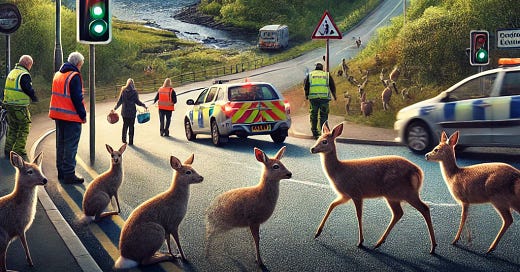Nature in Crisis and Coexistence - Environmental News Stories
From endangered birds at risk in Scotland, deer dilemmas, and an unexpected mass bird die-off in Australia, these are three pressing wildlife stories you need to know.
Before you ask, yes. This image is indeed AI-generated. I was thinking about a good way to start an article with a ton of news to digest, and I thought AI would be the best way to quickly catch your attention and give you a summary of what you are about to read. Ignore the fact that a few of the deers look unrendered. It’s still amazing what AI can do, nonetheless. As it is commonly said, a picture is worth a thousand words. But for my sake, you should read the following words anyway.
1. Suggested Green Energy Plan Puts Endangered Birds' Habitat in Scotland at Risk
A suggested green energy scheme close to Loch Awe in Argyll, Scotland, was criticized by the RSPB (Royal Society for the Protection of Birds) Scotland as it could pose a risk to the habitat of endangered curlews. The scheme, as conceived by the Intelligent Land Investments (ILI) Group, will build a 1,500 MW pumped-storage hydroelectric plant with a 45,000 MWh storage capacity. The degradation of peatland and carbon dioxide are the concerns given the excavation of about 1.6 million cubic meters of peat. Despite environmental reviews and proposed mitigation measures, opposition to the project by RSPB Scotland hinges on potential harm to special species habitats as well as other vital natural sites.

2. City Deer Populations Present Increasing Problems in American Cities
Cities all over the United States are being negatively impacted by expanding deer populations.
Even though some welcome having the deer nearby, the deer bring severe threats, such as car crashes, ecological harm, and health concerns about diseases like Lyme disease. Multiple measures have been put into place to deal with these problems. For instance, Eagle Mountain, Utah, uses deer-friendly zoning requirements and infrastructure, including wildlife bridges, to funnel deer safely through human development. Culling plans and vasectomies of deer are a few other methods tried, with Staten Island's vasectomy program seeing a 50% drop in deer population. These are typically costly and subject to various levels of public resistance, however. The incident serves to help us understand the delicate balance between human expansion and wildlife management.

3. Suspected Poisoning Causes Mass Death of Little Corellas in Australia
First of all, what even is a “Little Corella”? The little corella is a small white Australian cockatoo that is distinguishable by its friendly demeanor, squawk, and tight social ties. It lives in highly massive flocks, the intelligent bird being easy to live with in both urban and rural settings but also occasionally a pest due to their capacity for crop and infrastructure destruction. Anyways, back to the news.
More than 200 little corellas' suspected poisoning is being investigated by New South Wales authorities. NSW Environment Protection Authority (EPA) is evaluating the suspected pesticide misuse as the probable cause after displaying symptoms like bleeding, paralysis, and not being able to fly. Dead and sick birds have been spotted in numerous suburbs of Newcastle, such as Hamilton and Carrington, where corellas are known to gather. Local vets and wildlife rescue groups are arriving to support the surviving birds. Samples have been collected by the EPA and public help is being sought in accessing information about the incident.

These stories should serve as reminders of the fine line between progress as humans and nature. With every expansion of cities, development of renewable energy, and control of wildlife populations, we make long-term effects on common ecosystems. From saving birds on the endangered species list, seeking humane solutions for urban deer, or examining threats to native wildlife, awareness is the first step toward positive change. By being aware and active, we can seek solutions that consider both nature and human requirements. As a community, let's continue to navigate an ever-changing world and fight for a future where people and wildlife coexist.
One final segment in today’s article to cheer your mood up. I found this cool video of a pod of narwhals playing with their food using their tusks. This just further speaks to their intelligence. But I talked more about all of that in my previous article, which is conveniently linked here for you to read. Thank you for making it to the end this week!
Here are all the buttons you could ever need.





